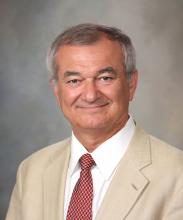User login
The multitude of problems that vascular surgeons encounter in the popliteal fossa will be the subject of “New Developments in Popliteal Entrapments, Aneurysms and Occlusive Lesions and Their Treatments” on Friday morning.
“As much as any other vascular bed in the body, the popliteal fossa highlights the value of the vascular surgeons’ toolkit, a detailed knowledge of the regional anatomy and the ability to perform open, endo and even non-vascular interventions in the case of popliteal entrapment,” said co-moderator Dr. Cynthia K. Shortell, professor of surgery at Duke University Medical Center.
The session kicks off with Dr. Niten Singh, professor of surgery at the University of Washington, exploring new developments and treatments in popliteal entrapment syndromes. Then the focus turns to popliteal aneurysms. Dr. Fred A. Weaver, chief of vascular surgery and endovascular therapy at Keck Hospital of the University of Southern California, will look at the scenarios when endograft or bypass for popliteal aneurysm may be appropriate, then Dr. Giovanni Pratesi, associate professor of vascular surgery at the University of Rome, dives into the use of endografts to treat thrombosed popliteal aneurysms.
The section on popliteal aneurysms closes out with a debate on endovascular repair. Dr. Martin Bjorck, professor of vascular surgery at University Hospital, Uppsala, provides scenarios when open repair is the preferred option. Dr. Eric Verhoeven and Dr. Athanasios Katsargyris, both vascular surgeons at Paracelsus Medical University, Nuremberg, will team up to present why endo is better in most cases.
The session closes with two presentations on popliteal occlusive disease. Dr. Patrick Peeters, head of cardiovascular and thoracic surgery at Imelda Hospital in Bonheiden, Belgium, will draw on new data from the FLEXION Trial to put the value of IN.PACT drug-eluting balloons (DEBs) in context. “DEBs in the infrapopliteal location did not do better at 12 months than regular PTA (percutaneous transluminal angioplasty) in the randomized INPACT-DEEP trial. Bbut for superficial femoral artery lesions DEB with optional nitinol stents resulted in less restenosis at 12 months than conventional PTA with nitinol stent in the DEBATE-SFA randomized trial. It will be interesting to see how DEBs perform now in the popliteal artery,” said Dr. Gloviczki.
The session closes out with Dr. Maxime M.S. Sibe’s presentation on whether improved stents have changed the treatment paradigm for complex popliteal occlusive lesions. “This presentation will boost interest in this technology and help us select the best patients for one or the other device,” Dr. Gloviczki said. Dr. Sibe is a vascular surgeon at Clinique Saint Augustin in Bordeaux.
“The debates and talks about popliteal aneurysms should help refine surgeons’ practices and help them choose which therapy is best for which patients,” Dr. Shortell said.
The multitude of problems that vascular surgeons encounter in the popliteal fossa will be the subject of “New Developments in Popliteal Entrapments, Aneurysms and Occlusive Lesions and Their Treatments” on Friday morning.
“As much as any other vascular bed in the body, the popliteal fossa highlights the value of the vascular surgeons’ toolkit, a detailed knowledge of the regional anatomy and the ability to perform open, endo and even non-vascular interventions in the case of popliteal entrapment,” said co-moderator Dr. Cynthia K. Shortell, professor of surgery at Duke University Medical Center.
The session kicks off with Dr. Niten Singh, professor of surgery at the University of Washington, exploring new developments and treatments in popliteal entrapment syndromes. Then the focus turns to popliteal aneurysms. Dr. Fred A. Weaver, chief of vascular surgery and endovascular therapy at Keck Hospital of the University of Southern California, will look at the scenarios when endograft or bypass for popliteal aneurysm may be appropriate, then Dr. Giovanni Pratesi, associate professor of vascular surgery at the University of Rome, dives into the use of endografts to treat thrombosed popliteal aneurysms.
The section on popliteal aneurysms closes out with a debate on endovascular repair. Dr. Martin Bjorck, professor of vascular surgery at University Hospital, Uppsala, provides scenarios when open repair is the preferred option. Dr. Eric Verhoeven and Dr. Athanasios Katsargyris, both vascular surgeons at Paracelsus Medical University, Nuremberg, will team up to present why endo is better in most cases.
The session closes with two presentations on popliteal occlusive disease. Dr. Patrick Peeters, head of cardiovascular and thoracic surgery at Imelda Hospital in Bonheiden, Belgium, will draw on new data from the FLEXION Trial to put the value of IN.PACT drug-eluting balloons (DEBs) in context. “DEBs in the infrapopliteal location did not do better at 12 months than regular PTA (percutaneous transluminal angioplasty) in the randomized INPACT-DEEP trial. Bbut for superficial femoral artery lesions DEB with optional nitinol stents resulted in less restenosis at 12 months than conventional PTA with nitinol stent in the DEBATE-SFA randomized trial. It will be interesting to see how DEBs perform now in the popliteal artery,” said Dr. Gloviczki.
The session closes out with Dr. Maxime M.S. Sibe’s presentation on whether improved stents have changed the treatment paradigm for complex popliteal occlusive lesions. “This presentation will boost interest in this technology and help us select the best patients for one or the other device,” Dr. Gloviczki said. Dr. Sibe is a vascular surgeon at Clinique Saint Augustin in Bordeaux.
“The debates and talks about popliteal aneurysms should help refine surgeons’ practices and help them choose which therapy is best for which patients,” Dr. Shortell said.
The multitude of problems that vascular surgeons encounter in the popliteal fossa will be the subject of “New Developments in Popliteal Entrapments, Aneurysms and Occlusive Lesions and Their Treatments” on Friday morning.
“As much as any other vascular bed in the body, the popliteal fossa highlights the value of the vascular surgeons’ toolkit, a detailed knowledge of the regional anatomy and the ability to perform open, endo and even non-vascular interventions in the case of popliteal entrapment,” said co-moderator Dr. Cynthia K. Shortell, professor of surgery at Duke University Medical Center.
The session kicks off with Dr. Niten Singh, professor of surgery at the University of Washington, exploring new developments and treatments in popliteal entrapment syndromes. Then the focus turns to popliteal aneurysms. Dr. Fred A. Weaver, chief of vascular surgery and endovascular therapy at Keck Hospital of the University of Southern California, will look at the scenarios when endograft or bypass for popliteal aneurysm may be appropriate, then Dr. Giovanni Pratesi, associate professor of vascular surgery at the University of Rome, dives into the use of endografts to treat thrombosed popliteal aneurysms.
The section on popliteal aneurysms closes out with a debate on endovascular repair. Dr. Martin Bjorck, professor of vascular surgery at University Hospital, Uppsala, provides scenarios when open repair is the preferred option. Dr. Eric Verhoeven and Dr. Athanasios Katsargyris, both vascular surgeons at Paracelsus Medical University, Nuremberg, will team up to present why endo is better in most cases.
The session closes with two presentations on popliteal occlusive disease. Dr. Patrick Peeters, head of cardiovascular and thoracic surgery at Imelda Hospital in Bonheiden, Belgium, will draw on new data from the FLEXION Trial to put the value of IN.PACT drug-eluting balloons (DEBs) in context. “DEBs in the infrapopliteal location did not do better at 12 months than regular PTA (percutaneous transluminal angioplasty) in the randomized INPACT-DEEP trial. Bbut for superficial femoral artery lesions DEB with optional nitinol stents resulted in less restenosis at 12 months than conventional PTA with nitinol stent in the DEBATE-SFA randomized trial. It will be interesting to see how DEBs perform now in the popliteal artery,” said Dr. Gloviczki.
The session closes out with Dr. Maxime M.S. Sibe’s presentation on whether improved stents have changed the treatment paradigm for complex popliteal occlusive lesions. “This presentation will boost interest in this technology and help us select the best patients for one or the other device,” Dr. Gloviczki said. Dr. Sibe is a vascular surgeon at Clinique Saint Augustin in Bordeaux.
“The debates and talks about popliteal aneurysms should help refine surgeons’ practices and help them choose which therapy is best for which patients,” Dr. Shortell said.


